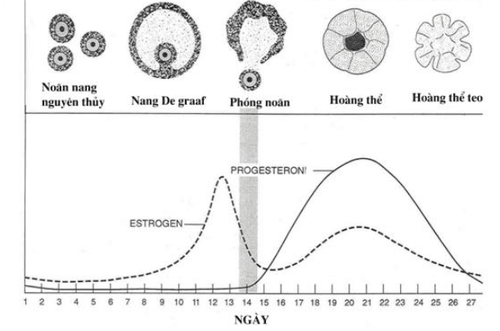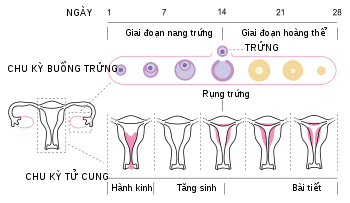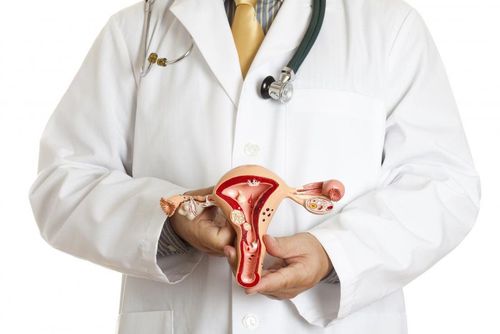This is an automatically translated article.
Menstruation occurs every month when women enter puberty and plays an important role in reproductive health. Therefore, women need to be equipped with knowledge about menstrual physiology to help monitor and control their health at this stage.
1. What is menstrual physiology?
The menstrual cycle is known as the physiological change made by the body's sex hormone system in women, including Estrogen and Progesterone. The physiological phenomenon of the menstrual cycle is associated with the monthly cyclical bleeding from the uterus to the outside of the body. It is caused by shedding of the uterine lining by the influence of sudden changes in sex hormones in the body. This phenomenon is completely considered as a normal development process in women.Menstrual physiology is carried out by the action of the hypothalamus, pituitary and ovary systems. The action of this axis system occurs and acts on the uterus to cause menstruation in women. The hormone GnRH released from the hypothalamus acts on the anterior lobe of the pituitary gland, stimulating the production of FSH and LH. The hormone FSH stimulates the follicles in the ovaries to grow larger. High levels of LH will work with FSH to make the follicles mature, stimulating the ovulation process. When the follicles have grown, the granulosa cells in the follicle cover secrete the sex hormone Estrogen. After ovulation occurs, the corpus luteum is formed at the site of the rupture of the follicle at the surface of the ovary, secreting Progesterone and a part of Estrogen. The hormone Estrogen has an effect on the endometrium causing it to become thicker and to increase the number of ducts. And the process of secreting Progesterone will affect the ducts of the endometrium, making this part become tortuous and secrete more mucus. After about 14 days of ovulation, the levels of 2 hormones, Estrogen and Progesterone, drop suddenly, leading to the shedding of the uterine lining and the appearance of menstruation.
When Estrogen and Progesterone rise to a certain level, it will affect the hypothalamus, stop secreting GnRH hormone and vice versa.

Estrogen và Progesterone là 2 hormone tham gia vào sinh lý chu kỳ kinh nguyệt
2. The phases of the menstrual cycle
A woman's menstrual cycle can begin from the beginning of puberty (about 12 to 17 years old) until the end of menopause (between 45 and 55 years old). The menstrual cycle in women can include the following phases:
Menstrual phase: This is the first phase of this cycle, also known as the menstrual phase in women. The period occurs when the egg in the previous cycle is not fertilized or pregnancy does not occur, causing the lining of the uterus to be shed and eliminated from the body through the vagina. Along with the decrease in the levels of the sex hormones Estrogen and Progesteron, causing the egg to be released along with blood and mucus, the uterine lining forms the menstrual cycle in women. At this early stage, a woman's body may show some signs such as menstrual or back pain, chest tightness, mood swings... This process usually lasts from 3 to 7 days, but in Everyone has a different amount of time and less time. Follicle occurs parallel to the initial menstrual period: This means that the follicle will begin when the first day of the menstrual cycle occurs and this phase will also end when the egg is released. This process is coordinated by the pituitary gland that receives the signal to release follicle-stimulating hormone. This hormone stimulates a woman's ovaries to produce between 5 and 20 small follicles, each containing an immature egg. The remaining immature eggs will be reabsorbed into the body. The mature follicles will change the estrogen hormone levels, thicken the uterine lining to create a favorable environment for conception and fetal formation. Ovulation can make a woman pregnant. When a mature egg is released from the ovary, it travels down the fallopian tube to the uterus, where it combines with sperm to fertilize a baby. Ovulation in a woman can occur on the 14th day of the menstrual cycle and within 24 hours conception can occur. At this time, if not fertilized, the egg will die and dissolve inside the body. The luteal phase: Occurs when the follicle releases an egg and the body releases the hormone Progesterone and Estrogen. At this time, the levels of these hormones increase to help thicken the uterine lining and prepare it for conception. In cases where conception occurs, the hormone Gonadotropin will help maintain the corpus luteum, keeping the uterine lining thickened to ensure the safety of the fetus. In cases where conception does not occur, the corpus luteum shrinks and is reabsorbed into the body. At that time, the levels of the sex hormones estrogen and progesterone decrease, the menstrual cycle occurs. The luteal phase can last from 11 to 17 days. Those who are not fertilized eggs will experience some signs such as breast tenderness, swelling pain or unusual mood, abdominal bloating and gas, insomnia, changes in sex drive or appetite more than usual.

Quá trình sinh lý chu kỳ kinh nguyệt được trải qua các giai đoạn khác nhau
3. Some properties of menstruation
The lining of the uterus during menstruation can shed unevenly in different areas of the uterus, where the lining has been, is or has not. So this time can last from about 3 to 5 days. When the mucosa is shed, it will be regenerated immediately and this mechanism has not been clearly elucidated. During the anovulatory menstrual cycle, the uterine lining is under the influence of the hormone Estrogen and there is no sinus of the arteriovenous connection, and at the same time, there is only the rupture of the spiral arterioles, so the menstrual blood is blood. arteries are bright red. But with an ovulatory cycle, menstrual blood will be darker or brown in color. This blood can flow from the sinus connecting arteries and veins, formed under the action of the sex hormone estrogen in combination with progesterone. In addition, menstrual blood is also a mixture of non-coagulated fluid, including mucus from the uterus or cervix, along with fragments of the uterine lining, vaginal and cervical sloughing cells.
Menstrual blood is composed of proteins and enzymes and prostaglandins. Blood clots in the vagina usually accumulate red blood cells, do not contain fibrin, the uterine cavity occurs fibrinolysis and protein. The breakdown products of fibrin cause very effective anticoagulation. Menstrual blood has a strong odor.
The amount of blood lost in each cycle can vary depending on age, ranging from 60 to 80ml. The amount of menstrual bleeding can be heavy in the middle days but is not related to the length of the cycle.
In summary, menstruation reflects the hormonal activity of the hypothalamic axis, pituitary gland, ovaries and the state of the uterine lining. This is also a measure of the evolution of a woman's sexual activity. Therefore, every woman needs to actively learn about menstrual physiological characteristics to know how to take care and protect her own health.
Please dial HOTLINE for more information or register for an appointment HERE. Download MyVinmec app to make appointments faster and to manage your bookings easily.













